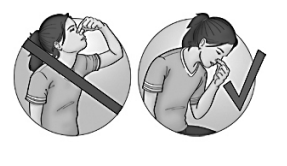What is epistaxis (nose bleed)?
Epistaxis is bleeding from the nose because of broken blood vessels at the front or back of the nostrils. It is usually mild and easily treated and controlled at home. If the bleeding is more severe, medical intervention might be needed to control the bleeding.
Why has it happened?
It is not always possible to give a definite reason. The common site for a nose bleed to start is in Little’s area. This is just inside the entrance of the nostril, on the nasal septum (the middle harder part of the nostril). Here the blood vessels are quite fragile and can rupture easily for no apparent reason. This happens most commonly in children.
This delicate area is more likely to bleed with:
- Trauma (a blow to the nose/picking the nose/presence of a foreign body).
- Colds and blocked stuffy noses such as with hayfever.
- Blowing the nose.
- Changes in temperature.
In the above situations, the bleeding tends to last only a short time and is usually easy to control. Bleeding sometimes comes from other areas further back in the nose. It is sometimes due to uncommon disorders of the nose, or to serious injuries of the nose. The bleeding may be more prolonged or harder to stop if you have:
- High blood pressure.
- Heart failure.
- Taking ‘blood thinning‘ drugs (anticoagulants) such as warfarin or aspirin.
- A blood clotting disorder.
General advice following a nose bleed

- Sit upright with your head tipped forward over a bowl or sink. Spit out any blood as swallowing
this may make you feel sick. - Apply continuous pressure firmly to the tip of the nostrils for 15 minutes. Breathe through your mouth while you do this.
- Keep cool and remove any surplus layers of clothing.
- Apply ice to the bridge of the nose and the nape of the neck as this may help constrict the blood vessels and reduce the bleeding. A cold compress (cold wet handkerchief) on the top of your nose or sucking ice may help you as well.
Things to avoid
- Avoid lifting, strenuous exercise (for at least 2 weeks after a bleed), constipation and stressful situations as they can cause your blood pressure to rise and increase the chances of a nose bleed.
- Do not blow, pick or attempt to clean the inside of your nose. The crusting discomfort you may feel is part of the healing process, and if you remove the crusts, you may infect the area or cause another nose bleed.
- Try to avoid sneezing, but if necessary, sneeze with your mouth open. This will stop sudden pressure within your nose.
- Alcohol, smoking and very hot drinks expand the blood vessels in your nasal lining and can increase the risk of further bleeding. Therefore they are best avoided for at least a week after the bleeding has stopped.
- Stay away from crowded, smoky places and if possible, from people who have coughs or colds as your nose is susceptible to infection and irritation while it is healing.
- Keep baths and showers cool.
- Avoid bending over for two week after the nose bleed.
- Do not sit beside a fire or radiator.
Attend your local Accident and Emergency Department if:
- Your nose is still bleeding after 30 minutes despite the above-mentioned general advice.
- The bleeding seems excessive.
- You’re swallowing a large amount of blood that makes you vomit.
- The bleeding started after a blow to your head.
- You’re feeling weak or dizzy.
- You’re having difficulty breathing.
Please contact your GP or NHS111 for any queries or concerns.
Download the PDF: